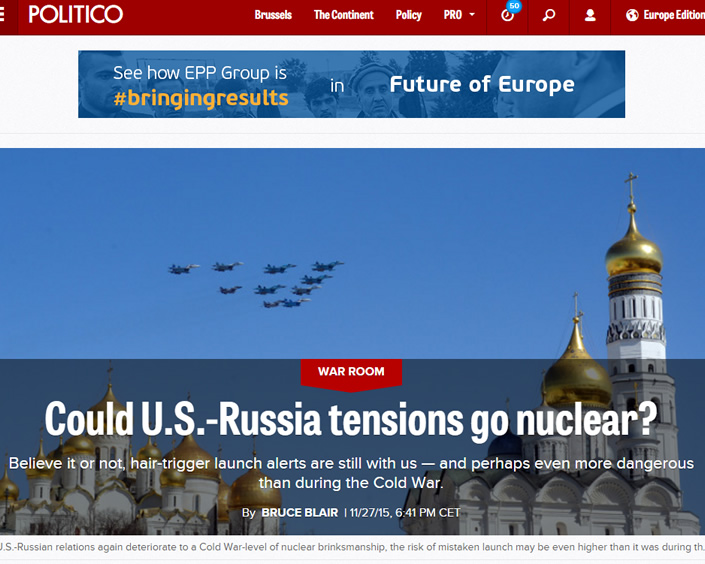Press Release
U.S. and Russia on a Hair-Trigger for Nuclear War
November 2015
Nov. 28, 2015 (EIRNS)—Hair-trigger nuclear alerts might be more dangerous now than at any time during the Cold War. This is the warning issued by Bruce Blair, a former nuclear launch officer and a co-founder of Global Zero, in an article posted by Politico, yesterday.

"Low-level military encounters between Moscow and Washington are fanning escalatory sparks not witnessed since the Cold War,"
Blair writes.
"And there exists a small but steadily growing risk that this escalation could morph by design or inadvertence into a nuclear threat."
The backdrop for this is the launch-on-warning posture of the nuclear forces of both the United States and Russia. "Our nuclear command system and forces practice it several times a week," Blair notes. "So do the Russians." Indeed, top Russian commanders, he says, can now launch missiles from their command posts directly, bypassing the entire human chain of command, in only 20 seconds. "In short, the slope between the low-level military encounters, the outbreak of crisis and escalation to a nuclear dimension is a steep and slippery one," writes Blair.
Blair goes through all of the elements of the U.S.-Russia confrontation that have developed since early 2014, the most significant of which is the Aegis destroyers that have been forward stationed in Rota, Spain, not because of their BMD capability but of something much more direct. In addition to the BMD missiles they carry, they also carry dozens of Tomahawk cruise missiles, which can hit targets in Moscow from the Black Sea. "That they may pose a decapitation threat probably underlies Russians escalatory response," Blair writes, including the harassment of U.S. ships with fighter jets and the deployment of submarines in the Black Sea. "Do U.S. leaders understand that the Russians may fear a decapitation threat is emerging, and that this threat may be the underlying driver raising the stakes for Russia to the level of an existential threat warranting preparations for the use of nuclear weapons?" Blair asks. "I doubt they do." Furthermore, Russia does not know for certain that those cruise missiles are not nuclear armed.
After that, Blair returns to the nuclear launch-on-warning danger, noting that the president of the United States might have 3-6 minutes of warning time to make a decision, and the president of Russia as little as 2-4 minutes. "This situation is a mistaken launch waiting to happen," Blair says, and its aggravated by the cyber warfare threat.
"The obvious solution is to eliminate nuclear weapons entirely, but of course that will not happen overnight," writes Blair. He offers seven steps that could be taken that would move the danger further away from midnight:
1) The United States and Russia could agree to eliminate launch-on-warning from their strategy;
2) They could agree to begin taking their strategic missile forces off of hair trigger, by adopting physical measures such as downloading warheads to storage that extend the time required to launch from the current period of minutes to a period of days;
3) All the nuclear weapons countries could agree to refrain from putting any nuclear forces on high alert except under tightly controlled conditions;
4) The U.S. and Russia could work with other nuclear establishments to share knowledge, best practices and technologies in the area of safety and security;
5) The U.S. and Russia, perhaps with China, could lead an effort to ban cyber warfare aimed at nuclear command, control, communications and early warning networks;
6) Confidence-building measures agreed to through military-to-military dialogue could help reduce the risk that geopolitical tensions around the world could escalate by design or inadvertence to the nuclear threshold.; and
7) Russian and U.S. leaders and experts need to consult on possible ways to reduce risks of crisis escalation growing out of the current U.S.-Russian tension and enhance prospects of resuming constructive bilateral discussions on a range of core security issues.
But another step preceding those seven is needed: the immediate removal of Barack Obama from the office of the presidency of the United States by Constitutional means, because for sure Blair’s seven steps aren’t going to happen as long as Obama remains in office, and the hair trigger could even be pulled in the meantime.
